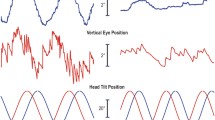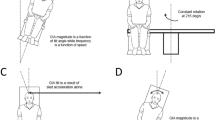Summary
The response to off-vertical-axis rotation (OVAR) was measured in cats under circumstances in which the signals from the horizontal semicircular canals and otoliths were opposed. Opposition was achieved by sudden acceleration or deceleration during constant velocity OVAR. The degree of opposition was expressed as a canal/otolith ratio where a ratio of unity indicated agreement. For a canal/otolith ratio of 1, the OVAR gain (eye velocity/ stimulus velocity) was 0.73 (±0.13). The steady-state OVAR response was, however, reduced if the canals and otoliths were opposed. The reduction depended on the degree of opposition with a fall-off of 0.15 gain/(unit of canal/otolith ratio). These findings are discussed with respect to the central velocity store and the mechanism underlying the generation of the OVAR response.
Similar content being viewed by others
References
Baloh RW, Lyerly K, Yee RD, Honrubia V (1984) Voluntary control of the human vestibulo-ocular reflex. Acta Otolaryngol (Stockh) 97: 1–6
Biguer B, Prablanc C (1981) Modulation of the vestibulo-ocular reflex in eye-head orientation as a function of target distance in man. In: Fuchs AF, Becker W (eds) Progress in oculomotor research. Elsevier, North Holland, pp 525–530
Blanks RHI, Curthoys IS, Markham CH (1972) Planar relationships of semicircular canals in the cat. Am J Physiol 223: 55–62
Correia MJ, Guedry FE (1966) Modification of vestibular responses as a function of rate of rotation about an earthhorizontal axis. Acta Otolaryngol 62: 297–308
Correia MJ, Money KE (1970) The effect of blockage of all six semicircular canals ducts on nystagmus produced by linear acceleration in the cat. Acta Otolaryngol 69: 7–16
Demer JL (1981) The variable gain element of the vestibulo-ocular reflex is common to the optokinetic system of the cat. Brain Res 229: 1–13
Goldberg JM, Fernandez C (1971) Physiology of peripheral neurons innervating semicircular canals of the squirrel monkey. I. Resting discharge and response to constant angular accelerations. J Neurophysiol 34: 635–660
Hain TC, Maria BL, Zee DS (1987) Modification of the dynamics of post-rotatory nystagmus by lesions of the cerebellum. In: Graham M (ed) The vestibular system: neurophysiologic and clinical research. Raven Press, New York (in press)
Harris LR (1985) The effect of opposing canal and otolith signals during off-vertical-axis rotation in the cat. J Physiol (Lond) 371: 30P
Harris LR (1986) Adaptation of the vestibulo-ocular reflex does not affect the response to off-vertical axis rotation in the cat. J Physiol (Lond) 382: 78P
Harris LR (1987a) Vestibular and optokinetic eye movements evoked in the cat by rotation about a tilted axis. Exp Brain Res 66: 522–532
Harris LR (1987b) Vertical canal stimulation abolishes horizontal velocity storage: effects on optokinetic nystagmus and eye movements evoked by a rotating linear acceleration. Int Meeting of the Barany Society (in press)
Harris LR (1987c) The eye movements evoked by a rotating linear acceleration vector depend on a central velocity storage mechanism. Brain Res 437: 393–396
Harris LR, Cynader M (1981a) The eye movements of the dark reared cat. Exp Brain Res 44: 41–56
Harris LR, Cynader M (1981b) Modification of the balance and gain of the vestibulo-ocular reflex in the cat. Exp Brain Res 44: 57–70
Judge SJ, Richmond BJ, Chu FC (1980) Implantation of magnetic search coils for measurement of eye position: an improved method. Vision Res 20: 535–538
McKinley PA, Peterson BW (1985) Velocity modulation of the vestibuloocular reflex in humans and its relation to smooth pursuit. Exp Brain Res 60: 454–464
Raphan T, Cohen B (1985) Velocity storage and the ocular response to multidimensional vestibular stimuli. In: Berthoz A, Melvill Jones G (eds) Adaptive mechanisms in gaze control. Facts and theories. Elsevier Science Publishers, North Holland
Raphan T, Cohen B, Kenn V (1981) Effects of gravity on rotary nystagmus in monkeys.In: Cohen B (ed) Vestibular and oculomotor physiology. Ann N Y Acad Sci 374: 337–346
Raphan T, Matsuo V, Cohen B (1979) Velocity storage in the vestibulo-ocular reflex arc (VOR). Exp Brain Res 35: 229–248
Waespe W, Buettner U, Henn V (1981) Visual-vestibular interactions in the flocculus of the alert monkey.I. Input activity. Exp Brain Res 43: 337–348
Waespe W, Cohen B, Raphan T (1983) Role of the flocculus and paraflocculus in optokinetic nystagmus and visual-vestibular interactions: effects of lesions. Exp Brain Res 50: 9–33
Author information
Authors and Affiliations
Rights and permissions
About this article
Cite this article
Harris, L.R. The contribution of the horizontal semicircular canals to the response to off-vertical-axis rotation in the cat. Exp Brain Res 71, 147–152 (1988). https://doi.org/10.1007/BF00247529
Received:
Accepted:
Issue Date:
DOI: https://doi.org/10.1007/BF00247529




